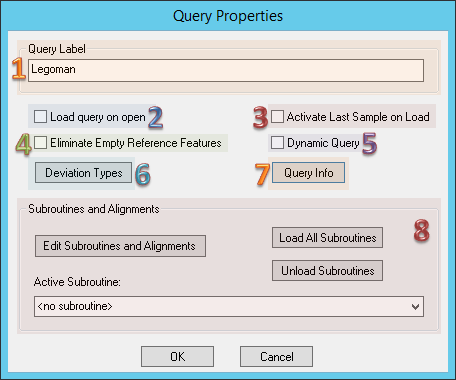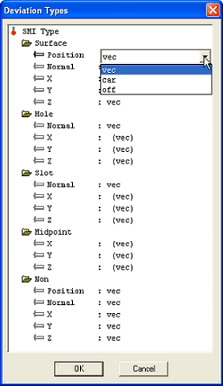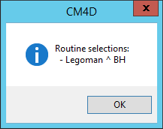 At any time you can edit the Query Properties. To do this, either double-click the Query label or right click on the desired Query and select Properties from the menu. The following dialog will appear.
At any time you can edit the Query Properties. To do this, either double-click the Query label or right click on the desired Query and select Properties from the menu. The following dialog will appear.
1. Query Label
The label of the Query. When a Query is created automatically after connecting to a database, the Routine label is used as the Query label by default.
2. Load Query on Open
When Load Query on Open is selected, the query will be loaded when the document is opened.
3. Activate Last Sample on Load
When Activate Last Sample on Load is selected the last sample (according to the ordering selected in the Samples dialog) will become the active sample. You can change which sample is active by Deactivating the default sample and Activating another sample.
4. Eliminate Empty Reference Features
When Eliminate Empty Reference Features is selected, reference features which are empty will not be included in the query.
5. Dynamic Query
Sets the Query as Dynamic, so that it will attempt to load any Routine rather than only the Routine set in the document.
6. Deviation Types
Deviation Types are set on the query level, rather than the DataSet level. There are three deviation types available- 'vec', 'car', or 'off'. Each SMI type has a separate deviation type corresponding to the Sift Rule SMI feature type (surf, hole, non, etc.). Deviation Types for new or migrated documents are determined by the settings of the [DeviationType] section of your cm4d.ini file.
Whether your cm4d.ini SetDevTypeFromDefaultSift is set to 0 or 1, all of your existing Single Sift Rule deviation type settings (act, dev, car, off, and ord) will be reduced to only 'act' and 'dev'. For the conversion of the rest of the deviation types in your document, your cm4d.ini file will be used to determine how they will be distributed.
For example, if your Single Sift Rules are set to 'dev', all of the deviation types in your migrated document will be 'vec' in the Deviation Types dialog on the query level. These standards also apply as follows:
Single Sift Rules = 'car', then all deviation types will be set to 'car'.
Single Sift Rules = 'act', then all deviation types will be set to 'vec' (default deviation type), even though actuals do not have deviation types.
Single Sift Rules = 'ord', then all deviation types will be set to 'vec' (default deviation type), as the 'ord' deviation type is obsolete.
When creating new templates, the cm4d.ini file TypeSmi settings will be used. Switching deviation types is primarily used in CM4Di. See the topic CM4D.ini File for more information on document migration and deviation type defaults.
To use different deviation types in a single document, you must create a new query to support each desired deviation type. Using multiple DataSets for this purpose is not supported. See the topic DataSet Sift Rules for information on setting Deviation Types on the DataSet level.
7. Query Info
If a Routine is saved for the Query, the Routine label will be displayed. This can be used if the Routine cannot be found in the database, you can find out which Routine the document Query is trying to connect to.

8. Subroutines and Alignments
Subroutines are a collection of features which have been selected from source routines and saved to the database.
Edit Subroutines and Alignments
Opens the Subroutines dialog.
Load All Subroutines
Clicking Load All Subroutines in the Query Properties dialog will load all of the subroutines in the DataSource.
Unload All Subroutines
Unloads the subroutines from the selected query.